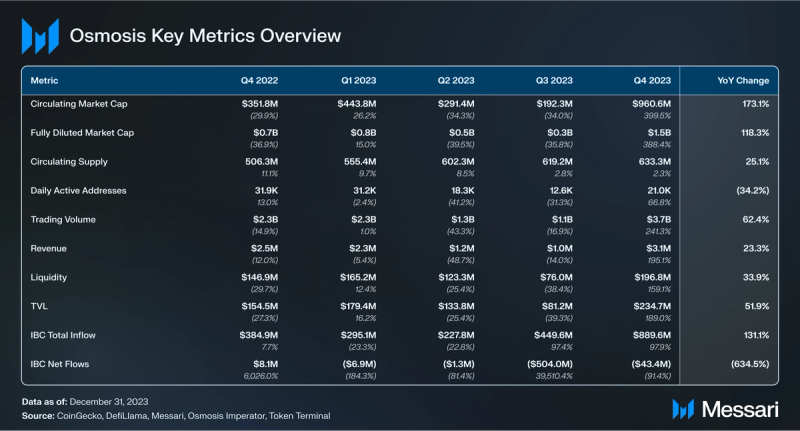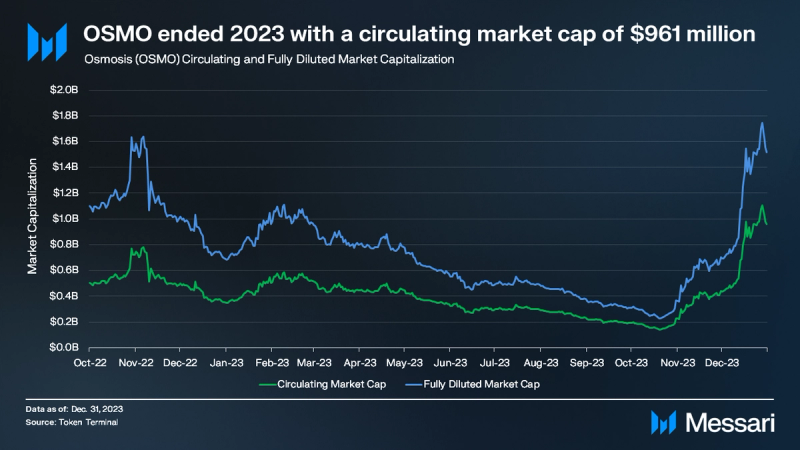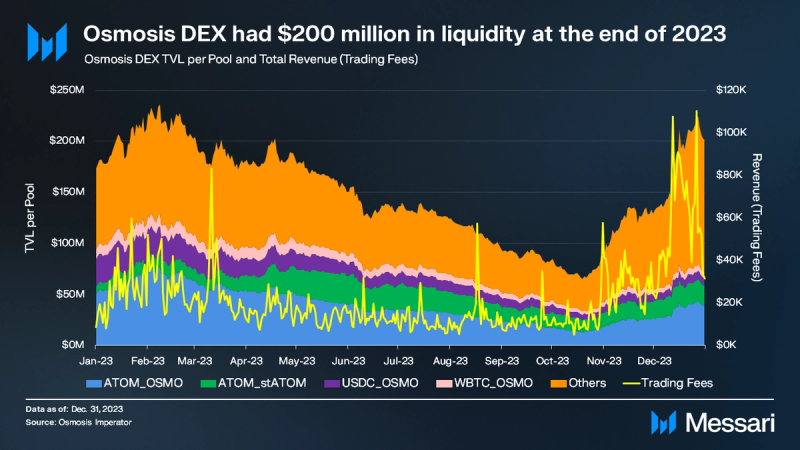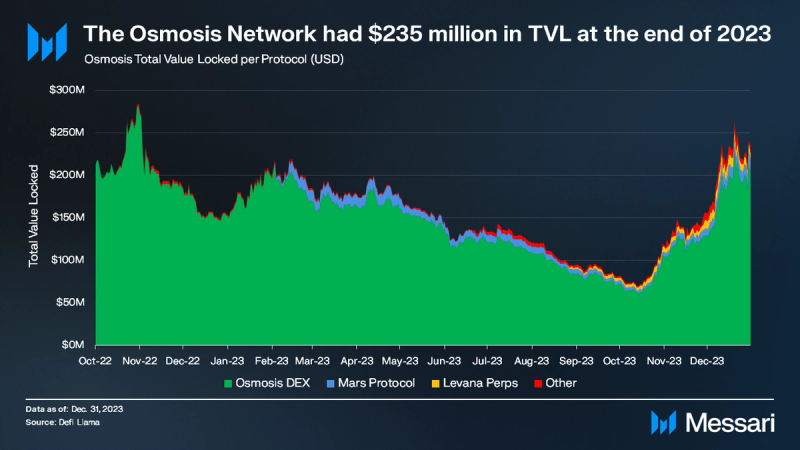Key Insights
- Osmosis DEX trading volume increased 241% QoQ to a total quarterly trading volume of $3.7 billion. Osmosis introduced volume splitting incentives, recalibrating incentives each epoch, targeting liquidity towards high-traffic, lower-fee pools.
- Osmosis DEX daily active addresses increased 67% QoQ, averaging 21,000.
- OSMO’s circulating market cap increased 400% QoQ from $192 million to $961 million. OSMO’s market cap ranks among the top 70 crypto protocols.
- Osmosis integrated with Celestia. The integration solution, named Pipette, unlocks bilateral liquidity in Celestia rollups and the Cosmos ecosystem, while also solving for UX challenges.
- USDC became the second leading token by trading volume. Circle launched its cross-chain transfer protocol (CCTP) on Noble, enabling native USDC minting within the Cosmos ecosystem.
Primer
Osmosis (OSMO) is a sovereign decentralized exchange (DEX) within the Cosmos ecosystem, focusing on automated market making (AMM) and liquidity provision. Osmosis distinguishes itself through its AMM as serviced functionality and customizable liquidity pools that allow for detailed adjustments in trading parameters.
The OSMO token plays a key role in governance and transaction fee operations. Token holders participate in protocol governance, impacting decisions on protocol upgrades and liquidity reward strategies. Transaction fees on the network are paid in OSMO (or any IBC token) and are distributed to stakers. The ProtoRev model uses the OSMO token for minting and burning to maintain onchain price balance. Trade taker fees are allocated partly to the Community Pool, with the rest benefiting stakers. Additionally, OSMO is involved in superfluid staking, which connects liquidity pool stakes to the network’s security.
Osmosis is the primary liquidity hub and trading venue of the Cosmos ecosystem. As an app chain, it supports the development of numerous complementary apps. Recently, Osmosis has added features like stableswap, concentrated liquidity, rate-limiting, and in-protocol MEV capture. These developments underscore its ongoing expansion as a full-service, cross-chain DeFi hub.
Key Metrics

Analysis

In Q4 2023, the entire crypto market cap increased, largely driven by anticipation surrounding the spot BTC ETFs. OSMO’s circulating market cap increased 400% QoQ from $192 million to $961 million, while its fully diluted market cap increased 388% QoQ from $310 million to $1.5 billion. The delta between the circulating market cap increase and the fully diluted market cap increase is the 2.3% QoQ inflation in OSMO (9.2% annualized). OSMO’s market cap ranks among the top 70 crypto protocols.

In the fourth quarter, Osmosis DEX saw an upswing in user activity. Daily active addresses increased 67% QoQ, averaging 21,000. This growth was accompanied by a rise in trading volume, which increased 241% QoQ, reaching a total of $3.7 billion.
During Q4, Osmosis introduced Volume Splitting Incentives in its V20 update. This mechanism recalibrates incentives each epoch, targeting liquidity towards high-traffic, lower-fee pools. It aims to boost trading volumes and reduce fees. This implementation benefits both liquidity providers and the protocol by optimizing trading routes. Osmosis also implemented a 0.1% taker fee on trades with Prop 651. This fee adds to the existing swap fee, increasing revenue generation for OSMO stakers. The change aims to directly link staker returns to the DEX’s performance. The swap fee was very effective in its first quarter, leading to a 195% increase in revenue.

In Q4, all leading tokens on Osmosis DEX experienced increases in trading volumes. OSMO led with trading volume of $1.3 billion, marking a 165% increase from the previous quarter and accounting for 35% of the total trading volume. Following that was ATOM, the second-largest non-stable token in terms of volume, which saw a rise to $489 million, a 178% increase QoQ, contributing to 13% of the total trading volume.
A notable launch in Q4 was TIA. It quickly emerged as a leading token, accumulating $227 million in trading volume in two months. Among stablecoins, USDC and USDT were the top performers, with trading volumes of $548 million and $201 million, respectively. The combined trading volume of tokens outside the top five reached $944 million, representing 26% of the total trading volume on the platform.

In Q4, the ATOM-OSMO pool led with a TVL of $38 million, followed by ATOM-stATOM at $20 million, USDC-OSMO at $7 million, and WBTC-OSMO at $6 million. The cumulative TVL for other pools reached $130 million, suggesting diversified liquidity. Revenue increased to $3.1 million, up 200% QoQ, reflecting the platform’s growing activity and liquidity distribution.

The Osmosis Network concluded 2023 with a Total Value Locked (TVL) of $235 million, 87% of which was attributed to the Osmosis DEX. Mars Protocol followed with a TVL of $15 million, Levana with $8 million, and the cumulative TVL of other protocols reached $9 million.
Notable events from the Osmosis ecosystem during the fourth quarter included:
- Circle launched its cross-chain transfer protocol (CCTP) on Noble, enabling native USDC minting within the Cosmos ecosystem.
- Osmosis integrated Bitcoin in collaboration with Nomic and Kujira, facilitating Bitcoin transfers to the Cosmos network via the Nomic bridge at a 1.5% transaction fee. This process issues Nomic Bitcoin (nBTC).
- Osmosis announced a planned merger with Umee’s UX Chain, introducing cross-chain lending features such as margin trading, liquidations, and flash loans.
- The launch of Token Info Pages offering deeper insights into the tokens hosted within the Osmosis DEX.
- The launch of the Staking Dashboard to improve the staking UX.
- The introduction of ‘Pipette,’ a liquidity and bridging solution, connecting the Cosmos ecosystem with modular chains like Celestia. Pipette unlocks bilateral liquidity in Celestia rollups and the Cosmos ecosystem, while also solving for UX challenges. It enables Celestia rollups to:
- Cross-chain payments using any token available on Osmosis
- Improve TIA accessibility across the modular ecosystem and beyond
- Access Cosmos assets to easily via Osmosis liquidity
- Quickly spin up new markets for rollup assets.
Closing Summary
Osmosis closed 2023 seeing huge increases across a number of key performance indicators. Osmosis DEX trading volume increased 241% QoQ to a total quarterly trading volume of $3.7 billion. During the fourth quarter, Osmosis introduced volume splitting incentives and a 0.1% taker fee. The updates were effective, leading to a 195% increase in revenue. Osmosis DEX daily active addresses increased 67% QoQ, averaging 21,000. OSMO’s circulating market cap increased 400% QoQ from $192 million to $961 million.
Additionally, Osmosis integrated with Celestia. The integration solution, named Pipette, unlocks bilateral liquidity in Celestia rollups and the Cosmos ecosystem, while also solving for UX challenges. USDC became the second leading token by trading volume. Circle launched its cross-chain transfer protocol (CCTP) on Noble, enabling native USDC minting within the Cosmos ecosystem.
Osmosis enters 2024 with increasing adoption, improving fundamentals, and quality partnerships with leading protocols. Look for Osmosis to continue building on these positive developments.



















